In this two-part series bulbs that can be grown in containers will be discussed, so acting as a focal point as part of your container garden. What will be noticed is that there are a large number of bulbs that can be grown in containers, covering all flower colours, heights, and forms.
Bulbs tend to do well when planted at the right depth in the compost and at the right time of year. Get it right and they will reward you with flowers for a number of years. Get it wrong and the bulb will rot in the compost that they are placed in. In order to succeed the growing conditions must just be right, not too wet, and not too dry.
The beauty of bulbs is that there is a variety that is in flower throughout the year. This means you can have a flower display in containers through all the four seasons. You tend to see people growing crocuses, daffodils, dwarf irises, hyacinths and tulips in spring and lilies in summer. There is much more to offer as you will see in this two-part series.
Some genera of bulbs have long flowering periods, for example, anemones can flower from February-April and June-October. The reason for this is that the genera contain a number of species that flower at different times. We are coming up to the best time to plant spring-flowering bulbs, so it is best to look through this list before deciding what to buy.
It is now time to plant your spring flowering bulbs and it is advised to go through this list before deciding which bulb to buy and plant.
What follows are bulbs that can be successfully grown in containers:
ACIDANTHERA (Abyssinian Gladiolus)

This gladioli-like plant has green sword-like leaves from which attractive fragrant white blooms with a dark centre are produced. It flowers in autumn where most bulbs have long passed their flowering season.
The bulb is not for everybody as it is not hardy and as a result, it has to be lifted before the frosts come and store in a cool, dry place. In spring it needs to be replanted when the danger of the last frosts have passed. The plant does well in dry and warm conditions.
Plant in well-drained multipurpose compost where it will grow up to 90cm. It may take a few years before flowering, so do be patient.
ALLIUM (Flowering Onions)
There are dwarf alliums and there are tall alliums, both can be used in containers. The flowers last a month and most are easy to grow, but they are not as popular as the other spring bulbs. Some of the flowering onions are fragrant, but it may be the strong garlic smell when the leaves are crushed may have put people off.
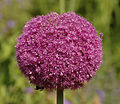
There is no standard leave or flower shapes. The leaves may be narrow or broad, whilst flowers may have wide or narrow petals. The flower heads come into two distinctive forms. The first one the flower head is spherical in nature, which is made up of many tightly packed blooms. These are known as the ball-headed alliums. Form 2 flowers are either loosely clustered in an upright position or the blooms droop. These are known as Tufted Alliums.
The ball-headed varieties often grow up to 60cm in height, where the domes of starry purple or white flowers are produced in May/June.
The Tuft alliums grow up to 23cm on height but tend to produce masses of yellow, pink, white or blue flowers.
Alliums will appreciate being grown in a well-drained multipurpose compost in full sun.
AMARYLLIS (Belladonna Lily)
Do not confuse this bulb with the large ‘Amaryllis’ bulb sold for growing indoors, especially around Christmas time. These are a variety of Hippeastrum and have a totally different growing habit.

This variety can be grown outdoors in a sunny, sheltered spot. Normally the indoor amaryllis produces the flower stalks first and the leaves after, but the outdoor variety the stalks appear a month or two after the green strap-like leaves have died down.
The only species found is A. belladonna, which grows up to 60cm in height, where fragrant, funnel-shaped pink, salmon or white flowers are produced.
The tall stalks will require staking to protect from wind damage. Cut down spent flower stalks and cover the crown with organic mulch to protect from frost damage. It will grow in well-drained, enriched multipurpose compost in full sun. No sun, no flowers.
ANEMONE
There is a wide range of anemones that can cover a wide range of growing conditions. There is no such thing as a typical anemone, as the blooms may be star-shaped or bow-shaped. The leaves can be fern-like or divided. Anemones can flower in late winter to spring, or summer to autumn. Underground they may be classed as tubers, rhizomes or fibrous roots.
Despite their different growing types, they can be split into three distinct groups: the daisy flowered anemones, poppy-flowered anemones, and Japanese anemones.

The daisy flowered anemones have many narrow petals surrounding a yellow centre. It flowers in spring. Normally you would plant the tubers and rhizomes in September. The daisy- type tend to grow up to 15cm in height.
Poppy flowered anemones have bowl-shaped flowers that are white, pink, red, lavender or blue in colour. The tubers need to be soaked overnight in water before planting the claws upwards in September. They will flower in March-April. Alternatively, you can plant in March-April for flowering in June-September.
The Japanese anemone is not a bulb but a border perennial and so will not be discussed here.
They all prefer a well-drained multipurpose compost. Some can be grown in semi-shade, whilst others like full sun.
ANTHERIUM (St Bernard’s lily)

You will not find this summer-flowering bulb in garden centres, although it has been a feature in gardens for centuries. The lack of popularity is not due to growing difficulties, but the problem is that it is a slow starter. It takes two years for the white starry flowers to appear. The plant grows up to 60cm in height when grown in a well-drained, enriched multipurpose compost. It can be grown in full sun or in light shade.
ARISAEMA

Not easy to find and expensive to buy. If you are looking for an unusual bulb then this is for you. The broad shiny leaves appear after the pink/white flowers. The tubers are normally planted in September, where the flowers appear in May-June. These are followed by red berries. Arisaema prefers well-drained, humus enriched compost in full sun or partial shade.
ARISARIUM (Mouse Plant)
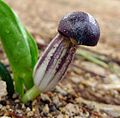
The strange looking flower that appears in March gives this unusual plant its appeal in the container garden. The leaves are arrow-shaped but the bloom that gives it its common name. The long tail at the top of the flowers, are purplish brown in shade, giving an appearance of mouse disappearing down a hole. It will grow up to 15cm tall in a well-drained, humus rich compost in partial shade.
ARUM (Cuckoo Pint)

The cuckoo pint appears above its narrow leaves between April and June. It can be grown in well-drained, humus rich compost where it will grow up to 45cm in height. The flowers are spectacular, but the red autumn berries are very attractive. Do be careful as the berries are poisonous.
ASPHODELUS (ASPHODE)

This showy, easy to grow bulb normally has to be ordered from a specialized bulb company. The asphodelus bear tall spikes of white or yellow, star-shaped flowers in May-June. After this long attractive seed heads appear. The rhizome-like roots, either dispatched in spring or autumn, should be planted immediately in a well-drained multipurpose compost in full sun. It will grow up to 45cm in height.
TUBULAR BEGONIA
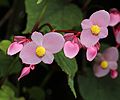
Most gardeners prefer to grow their own with shop bought tubers. The tubers are normally pressed down with its hollow side facing upwards. This should be done in March, and temperature must be consistently between 15 -21 degree Celsius. Once the leaves appear it can be transplanted into its final container. The leaves are serrated and angular, where the plant can grow up to 45cm tall in containers full of multipurpose compost in light shade. The tuber needs to be lifted in October and stored in a dry place.
BELAMCANDA (Leopard Lily)

You will need to search high and low for this bulb, as it is not a garden centre plant. This is probably due to its reputation of being too tender.
This 75cm tall plant flowers in summer, where the yellow or orange petals are streaked with red (hence its common name). The flower only lasts a day but many more are produced. The seed pots split open revealing clusters of shiny, black seeds.
It likes a well-drained enriched compost in full sun or partial shade.
BLETILLA (Chinese Ground Orchid)
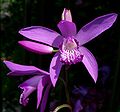
Orchids are not to be found in the open in this country. This is the only one which can be grown in containers outside. The compost must be free-flowing and must not be placed away from frost pockets. It will require frost protection so much using pine needles or leaf mould. The flowers are pink or mauve. It grows up to 45cm in height when planted in well-drained multipurpose compost in full sun.
BRIMEURA (Spanish Hyacinth)

Dutch hyacinths are easy to find, the Spanish one not so much so. It may look more like a bluebell than a hyacinth. The plant flowers in May-June, where long blue tubular flowers are formed. The flowering spikes tower over the grassy green leaves. Flower colours are normally blue but a white version does exist. Grow in full sun in a well-drained multipurpose compost, where it will grow up to 30cm in height.
BRODIAEA
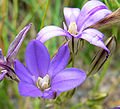
This is one of the most confusing genus. The species may look different from each other and each species may belong in three different genus names. The slender flower stalks bear clusters of star-like or tubular blooms, over narrow strap-like green leaves. Plant in a light multipurpose compost in a sheltered, sunny spot. It will grow up to 60cm in height under these conditions.
BULBOCODIUM (Spring Saffron)

At first glance looks like a crocus, but look closely and the differences are noted. Leaves look small when the large pink blooms are produced. They are short plants only growing up to 15cm in height when planted in a well-drained multipurpose compost in full sun.
CAMASSIA (Quamash)

This bulb likes the compost to be moist but not waterlogged especially in winter. Large starry blue flowers on tall spikes are borne in May –early June. The leaves are strap-like and are produced before the flowering spike.
It will grow up to 90cm in height when planted in multipurpose compost mixed with water retaining crystals. Need to be watered copiously in dry weather.
CANNA (Canna Lily)

This is one eye-catching bedding plant as no other plant can beat this as an interesting focal point. The plant can grow up to 1.2m in height, with 30cm long paddle-shaped leaves that are often brightly coloured. The striking flowers are bright yellow in colour, with splashed of oranges. These are produced from July to the first frosts.
Plant in multipurpose compost with added slow release fertilizer. It is not a plant for everyone as it requires a sheltered spot in full sun.
CARDIOCRINUM (Giant Himalayan Lily)

This is a tall plant that can grow up to 2.7m in height. It is very unusual and therefore Worthing looking for an online supplier. Giant Himalayan lily needs to be planted in a large container, 90cm apart or grow one bulb per large container in October.
In summer long stout stems are produced, with white lily-like flowers with red markings are borne in clusters.
Use a multipurpose compost that is mixed with water retaining crystals. Moisture and light shade is important. The biggest problem is that the main bulb dies after flowering, but offsets are produced. These offsets will take years in order to flowers so you will need to buy new bulbs every year for a display.
CHIONODOXA (Glory of the Snow)

This is a popular spring bulb but is not as often seen as crocuses or snowdrops. The six-petalled flowers are borne on sprays above grass-like leaves. You can plant them in groups in a container or mixed with other spring bulbs. They will grow up to22cm in height when planted in a well-drained multipurpose compost in full sun or light shade.
COLCHICUM (Autumn Crocus)

This is not the same bulb that is often found in spring containers, although the flowers look similar. They are not related. The plants can grow up to 20cm in height, where in autumn wide-shaped blooms of pink, lilac or white appear. Before winter arrives the blooms disappear, where in spring the large leaves once again appear. It needs a multipurpose compost mixed with a slow release fertilizer in full sun or light shade to do well. Beware all autumn crocuses are poisonous.
CONVALLARIA (Lily of the Valley)

Convallaria does well as a spring flower under the cover of trees and shrubs, where it can be underplanted in containers. The small pendant white flowers appear at the same time as the large lance-shaped leaves. The leaves can also be variegated. One thing that this bulb is noted for is the flower scent, as it is divine. It grows up to 30cm in height when planted in a moisture-retentive multipurpose compost. Does best in partial shade.
CRINUM (Swamp Lily)
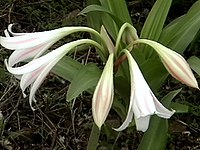
This is not a hardy bulb, which is a pity as it is one of the showier bulbs. It is a large bulb in size, producing a 90cm tall plant. The flower spikes produce long lily-like flowers in late summer. It needs the protection of a sheltered site in summer and the crown will need protecting in winter. The best bet is to move the container into a greenhouse or a conservatory. Grow in well-drained moisture retentive multipurpose compost in a south- facing position. It requires plenty of sun in order to thrive.
CROCOSMIA (Montbretia)

This plant tends to be found in gardens everywhere. It is a spreading clump-forming plant and so it is best to grow as a sole specimen in a large container. The plant grows up to 90cm in height, where sword-like leaves are noted, along with flower stems of orange, yellow, or red starry or tubular blooms are produced.
Grow in a well-drained enriched multipurpose compost in a sheltered position. Note that not all varieties are totally hardy so mulching may be required.
CROCUS
The crocuses most people are aware of are the Dutch Hybrids, which flowers before the tulips but after the snowdrops. The range is more extensive than this where there are crocuses flowers between January and October. All crocuses produce flowers that are goblet in shape with six petals.
Plant the corms between September to November for spring flowering, or July for autumn flowering. There are four basic groups, all growing up to 13cm in height. All have the behaviour of the blooms opening in full sun to reveal a starry shape, that closes when it gets darker. The leaves continue to grow after flowering.

The showiest is the Dutch or Large Flowering Hybrids that produce blue, purple or white flowers between March-April. Some Yellows do exist but it is not common.
Chrysanthus Hybrids flower between February-March, and produces blooms that are medium sized and fragrant. They are mostly yellow, but blends of white, blue and mauve are known. The spring flowering species are more dainty and small. They can flower in January or as late as April, depending on the variety bought.
Finally, there are the autumn flowering species that flower between September and December. All crocuses do well when planted in well-drained multipurpose compost in full sun or light shade. Can be used as a sole specimen or mixed with other bulbs to give a beautiful display.
DIERAMA (Wand Flower)

This eye-catching bulb is not often seen in gardens, which is a shame. It grows up to 1.5m in height when planted in a large container full of well-drained multipurpose compost in full sun.
It can be raised by planting corms in late autumn or spring, but the usual method is to but a pot grown specimen. The long grassy leaves are semi-evergreen and from late summer bell-shaped violet flowers appear on arching thin stems.
ERANTHIS (Winter Aconite)

This is another tuber that can be planted under trees or shrubs in containers. In February you will be rewarded with a glossy yellow carpet of flowers. The flowers appear first, on stems that bear a frilly green collar.
The plant grows up to 8cm in height when planted in a well-drained multipurpose compost in full sun or partial shade. Looks bests when grown with snowdrops in full sun. It can be raised by planting corms in late autumn or spring, but the usual method is to buy pot-grown specimens.
ERYTHRONIUM (Dog’s Tooth Violet)

This bulb often does well when planted under trees and shrubs in containers. The plant grows up to 30cm in height, where nodding yellow flowers are borne over broad leaves, which are often streaked with brown.
They like a well-drained humus rich multipurpose compost in partial shade. The tubers must not be allowed to dry out between purchasing and planting. The common name comes about because of the shape of the tubers.
EUCOMIS (Pineapple Lily)

The common name is derived from the shape of the flower head, where oval masses of small creamy white flowers are noted over a leafy crown above. The flowers are produced between July and August. It can grow up to 60cm in height when planted in a well-drained multipurpose compost in full sun.
Do not try to grow it outdoors in cold areas. It is best to grow them in containers that stand outside during the growing season and then brought into the greenhouse or conservatory before the first frost arrives. The leaves die back in winter, but keep the compost dry until new growth emerges in spring.
FREESIA

Outdoor freesia is bulbs that can be grown in a sunny sheltered area. These are not the same plants as those used by florists. The corms have been specifically prepared to be grown outside in our climate. The plant grows up to 45cm when planted in a well-drained sandy multipurpose compost in full sun.
The fragrant flowers are produced in August to October on wiry stems. The major drawback is that the bulb has to be thrown away after it has flowered. You need to buy new bulbs every year.
FRITILLARIA (Fritillary)
The bell-like flowers of fritillary open in spring, where they hang downwards from the top of upright stems, with narrow leaves. This is where the family resembles ends as the species vary in shape, size and cultural needs.

The usual varieties are Crown Imperial and Snake’s head fritillary. There are easy to grow as all you need is a free-draining multipurpose compost in a sunny location.

Crown imperial grows up to 90cm in height, whilst snake’s head fritillary grows up to 30cm in height. Plant the bulbs between September and November by pacing coarse sand in the planting hole and placing the bulb sideways. Cover the bulb with more sand and then replace the compost on top of it. This will stop the bulb from rotting.
GALANTHUS (Snowdrops)
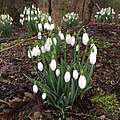
The snowdrops are the herald of the new gardening year, as it tells you that spring is just around the corner. From January to March, small white flowers that hang from 15cm stems are produced.
This is so dependent on the variety that is chosen, locality and the weather. Plant the bulbs in moist multipurpose compost in light shade, as soon as possible after purchase in September or October. You can also buy the plant as greens, where the leaves are already growing, which is believed to have more success than bulbs.
GALTONIA (Summer Hyacinth)

This tall growing bulb grows up to 90cm in height, where long white flowers are produced between August and September. The leaves are long and strap-like, and the plant looks like a giant hyacinth. It is easy to grow as the bulbs are planted deeply in March—April.
You can leave the clumps that form undisturbed for a number of years. Grow in well-drained humus rich multipurpose compost in full sun. Once flowering has finished and the stalks have withered, cut the stems off and cover the crown with a thick layer of mulch. This will protect it from frosts.
GLADIOLUS (Sword Lily)
This bulb familiar to most gardeners has sword-like leaves, from which an upright flowering stem emerges. The spikes are adorned with irregularly shaped trumpet-like flowers during the summer months.
At first glance, all gladioli look similar but there are large differences between the various types. The flowering stalks may be short as 30cm or as tall as 1.2m. The flowers can be small as an egg cup to the size of a small saucer. They cover all colours of the rainbow but the lips of the flowers can be plain, hooded, frilled or ruffled. They are not fully hardy so need to be dug up before replanting in spring of the following year. Store the bulbs in a dry frost free place.
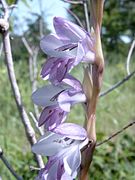
They are easy to grow in good multipurpose compost in a sunny pot. Water thoroughly during dry weather. Once the flowering spikes appear they will need stalking in order to prevent wind damage. The flowers are only produced over a two week period so you will need to plant at two-week intervals to get continuous colour in your container garden.
The hardy gladioli corms are planted in October and flower in May-June.
CONCLUSIONS
In this first part of growing bulbs in containers, plants that are suitable have been described. There are a large number of varieties that can be used to give colour and form to your container garden. No matter your preference there is a bulb for you.
In the next part bulbs from H-Z will be discussed. Looking forward to seeing you in the next part.
If you have any comments or questions that you wish to raise, please leave them in the comment box below.
Happy Container Gardening.


Lots of variety here, especially considering it’s a two-part series. For those who garden and love variety, growing bulbs in containers would be the ideal avenue to go, especially in the spring and summer. What’s also interesting is that you brought the point some of these bulbs have growing seasons when it’s not as hot out, such as February to April, for example. It really jumped out at me that those passionate about bulb growing can get a nice head start in the early months of the year while completing their variety later on. It’d be a fun hobby to get into.
Hi Todd
Thank you for those kind words. Bulbs tend to be easier to grow and can give colour at various months of the year. Bulbs are an easy way of getting into container gardening, as the chance of success is greatly increased. Yes, gardening is a good hobby and is good for your wellbeing, both physically and mentally.
Kind Regards
Antonio
I am getting more and more into gardening each year. I have not tried growing bulbs yet, though. I would love to give this a try and you have given some great suggestions. My cat does try to eat all my plants though. I know lilies are bad for cats, but I’m not sure about others. Do you have any suggestions for pet-safe plants?
Hi Holly
Thank you for that question, my understanding is that most bulbs are fine, apart from these ones; Autumn crocus, part of the lily family, daffodils, lilies, Hyacinths and tulips. The rest should be okay but they may cause stomach upsets.
Thank you for the question.
Antonio
Wow. Such a wide variety of flowers and it’s not even complete. I am having a hard time remembering a lot of names. What is your best recommendation for my garden? I am looking to add two flowers and I want something that is easy to take care since I am not always at home
Hi Vincent
Thank you for those words. The choice is up to you, as all bulbs tend to be easy to maintain, with little required in the way of watering and feeding. My personal favourite are Crocuses and Anemones.
Kind Regards
Antonio
I found this so perfectly timed as I am moving to a place that has more land and the freedom to have more plants/flowers/etc!
I would love to take a class on gardening as I can usually prosper in vegetable gardening, my green thumb with household plants seems to teeter. I feel like I learned so much reading this– knowing the depth of which to plant the bulbs for success is amazing. I feel like I think about this often for vegetable plants, but never stressed about it for flowers (which makes total sense why it would matter!).
I am from a cold climate so some bulbs will obviously do better than others in these parts of the Northeast!
I look forward to trying out my skills this year– thanks for the encouragement!
–Ciara
Hi Ciara
Thank you for your kind remarks. Growing flowers, especially bulbs will provide a feast for your eyes and not your stomach. Give it a go and your outside container garden will look more beautiful. If you want to grow vegetables you can consult my article here.
Thank you
Antonio
It is amazing seeing bulbs grow in the container. All my thoughts was that onions can not be plant inside container. I have tried planting onion inside container before and it turns out being rotten. I love container farming and I have planted so many vegetables which turned out to be great. My outcome from onion gave me impression that it can’t grow inside a container. Could it be that I didn’t follow normal step? I’ll love to Know more about this. Great review from you. Gracia!
Hi Stella
In this article I am talking about flowering bulbs which are a different kettle of fish. I have written an article on growing vegetables in containers that can be found here. Onions are not worthwhile to be grown in containers but you can try the rest
Thanks
Antonio
Hello Antonio :),
I am a bit partial to gardening as i see it as too much work but i do love these beautiful bulbs you have have written about. i am also sold on the fact that these can be grown on container.
The Chinese Ground Orchid looks amazing. I cannot wait to read the part two of this amazing series. Kudos
Hi
Thank you for those kind words. Container gardening must not be seen as hard work but sowing the seeds for future success. There are ways you can minimise your time in the garden by selective planting. I will be writing an article on this.
Kind Regards
Antonio